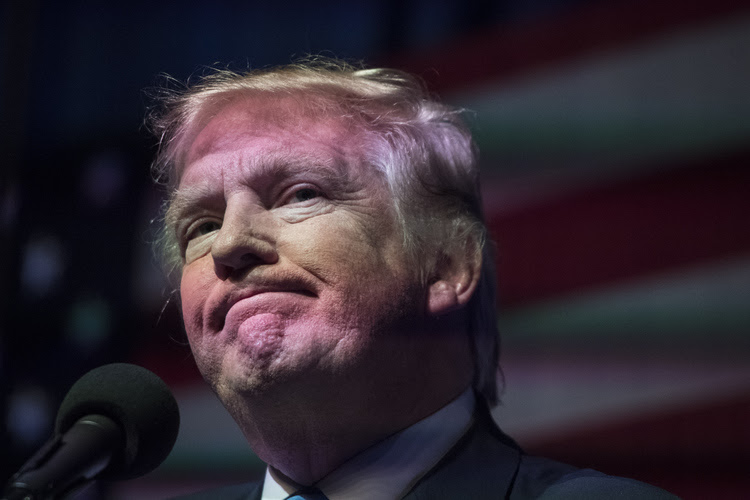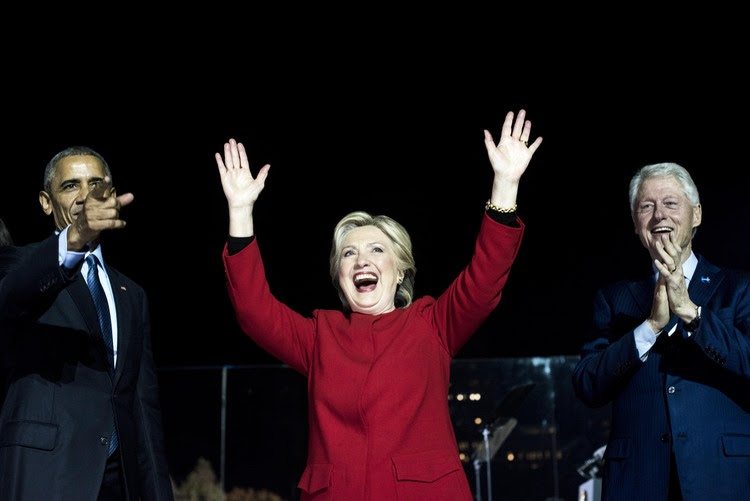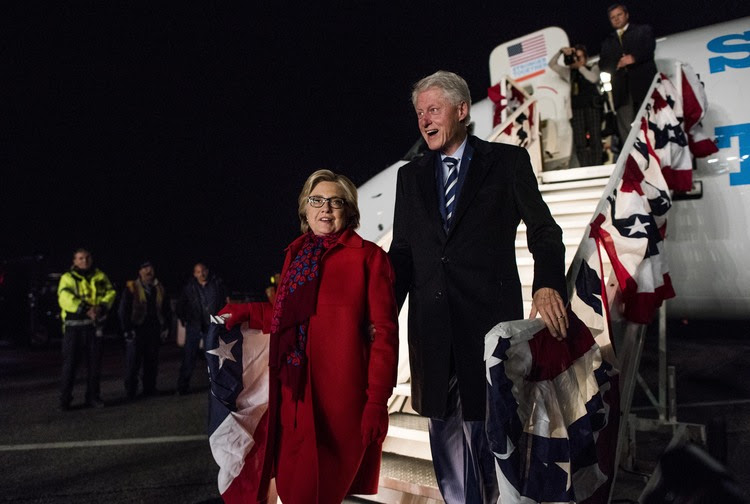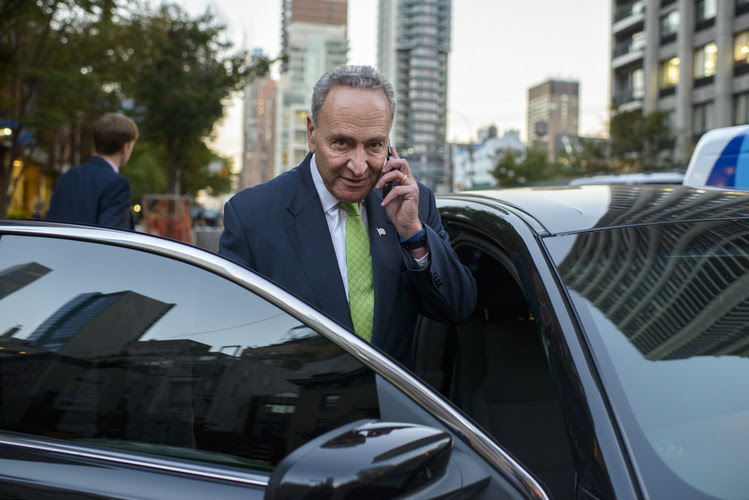THE election outlook from the +Washington Post .......
The Daily 202: The 2016 map might look just like the 2012 map, but this election could still foretell a realignment
 |  |
| The 2016 map might look just like the 2012 map, but this election could still foretell a realignment | ||

Donald Trump campaigns yesterday in Scranton, Pa. (Photo by Jabin Botsford/The Washington Post)
THE BIG IDEA: John McCain’s final stops to close out the 2008 campaign were in New Mexico and Colorado. George W. Bush, garnering 44 percent of the Latino vote, had carried both in 2004. Barack Obama, meanwhile, visited Indiana on Election Day eight years ago, which he subsequently won. The Democratic nominee that year also spent time during the final stretch in Missouri, which he lost by fewer than 4,000 votes out of 2.9 million cast (that’s 0.13 percent). If Donald Trump wins today, and he still could, his path to the presidency will go through the Midwest. In a reflection of how the political terrain has changed in just two presidential elections, the Republican nominee is almost certain to lose New Mexico and Colorado but win Indiana and Missouri with no real effort. The states likeliest to move into the Republican column are Iowa and Ohio. While McCain wrote off Michigan in September, and Mitt Romney never made a real play for his home state, Trump has devoted significant attention there lately. At 12:30 a.m., he took the stage in Grand Rapids for the final rally of his campaign. Tightening polls forced Hillary Clinton to travel twice to Michigan in the final four days, in addition to her husband and President Obama. Worried about lagging African American turnout in Detroit, the Democratic nominee tried to appeal to moderate whites in western Michigan by invoking Gerald Ford during an appearance in his old House district. “I was privileged to know, as a college student, Gerald Ford,” she said in Grand Rapids, a few hours before Trump arrived. “In fact I had an internship with the House Republican Conference Committee, which he headed, after my junior year in college.” Working-class whites have also helped Trump close the gap in Wisconsin, which he visited last week, and they are why his team has (totally misguided) hope for an upset in Minnesota. -- Trump’s center of gravity during the primaries was somewhere in the South. His base during the general has been the Rust Belt, where voters tend to be older and whiter than the country as a whole. Millions of folks in this sprawling region, buffeted by decades of deindustrialization, feel left behind. They have proven especially receptive to someone preaching the easy answers of nationalism, protectionism and isolationism. 
Obama introduces HRC at Independence Mall in Philadelphia last night. (Melina Mara/The Washington Post)
-- The Clinton campaign recognized pretty early that Pennsylvania needed to be its firewall and behaved accordingly. The Keystone State has proven to be a siren song for Republicans since George H.W. Bush won in 1988. Bush 43 came very close in 2004. Romney made a quixotic, 11th-hour visit four years ago but basically invested no resources and lost by 5.4 points. It will probably be closer this year. This is why Clinton devoted time yesterday to the population centers of Pittsburgh and Philadelphia. She held a huge rally in Philly last night with Bill and both Obamas. She is going to underperform in the western parts of the state but remains favored to ultimately prevail if African Americans show up in the City of Brotherly Love and moderates break her way in the collar counties, which are decidedly not part of the Rust Belt. -- Despite the shift in the battlegrounds over the last decade, it is completely conceivable that the electoral map tonight might wind up looking eerily like it did in 2012. In fact, Trump is likelier than not to end up with more electoral votes than Romney -- thanks to the Hawkeye State, as well as perhaps the Buckeye and Sunshine States. Because Mitt lost all three, North Carolina is really the only state which could turn blue. 
There was a laser show at SNHU Arena as Trump came on stage in Manchester last night. (Jabin Botsford/The Washington Post)
-- In a testament to how polarized the country has become, there are not landslides anymore. Lyndon Johnson won 44 states in 1964 (everywhere outside the Deep South and Barry Goldwater’s home state of Arizona). Richard Nixon won everywhere but Massachusetts in 1972. Ronald Reagan won everywhere but Minnesota in 1984. Bill Clinton carried 32 states in 1992 and 31 states in 1996. In the best case scenario for Hillary tonight, if she “runs the table,” she will win no more than 28 states. -- Assuming the election turns out as the polls and the models forecast, many Republican leaders will downplay the results. Party apparatchiks will blame Trump and the exogenous circumstances he created. Indeed, this was a very winnable election: History was on their side. If anyone but Trump was the nominee, there would never have been any buzz about Utah being in play. Independent Evan McMullin would not have run. It stands to reason that future nominees will not do as poorly among college-educated white women again. Mitt Romney carried this group by six points, but the most recent polling has Trump -- who more than a dozen women have accused of sexual assault – trailing Clinton by 27 points. Trump’s allies will say, if they lose, that the outcome might have been different had members of the establishment such as the Bushes, Romney and Ohio Gov. John Kasich stuck with him. RNC leaders insist that they will not produce another autopsy, as they did after 2012, because there is no need to. (The old report makes for good reading and still applies, considering how few of the 219 recommendations were followed.) 
The crowd watches Clinton speak in September at the Congressional Hispanic Caucus Institute’s annual gala in Washington. (Melina Mara/The Washington Post)
-- Just saying the overall map is static is overly simplistic analysis that misses some pretty profound changes happening under the surface. (It also misses the fact that an unchanged map from 2012 would mean permanent minority status for Republicans.) Until James Comey’s bombshell October surprise, which brought recalcitrant Republicans home to Trump, Clinton was making a meaningful play to expand the map – namely with a major investment in Arizona. -- All evidence suggests that the Latino sleeping giant really is finally waking up. This will make it harder for Republicans to win in Western states that were strongholds not long ago. Early voting numbers suggest that Nevada, which Bush 43 carried twice, has probably slipped away from Trump – and that will cost Republicans the chance to pick up Harry Reid’s Senate seat. Colorado has not been a true toss up since the beginning of the general election phase of the campaign, and Democratic Sen. Michael Bennet is coasting to reelection. Of the eight states that have Hispanic populations larger than the national average, Trump is only certain to win Texas. Trump could still win Florida narrowly, but that’s only because around two-thirds of the electorate is white. Less than one in 10 Republican voters in 2012 were non-white, and that number could actually be lower in 2016. There are still lots and lots of white people in America – enough, in fact, to win Trump this election – but their share of the electorate will only continue to decline:  Many hombres, as Trump derisively referred to Mexican immigrants at the last debate, are turning out for the first time. The University of Florida’s Daniel Smith calculated that 36 percent of Hispanics who cast early ballots in 2016 did not vote in 2012. Democrats finished early voting with at least an 88,000-vote lead in Florida because of historic turnout in Miami-Dade and Broward. “If Clinton wins Florida — and therefore the presidential race — it will be on the strength of these two urban counties,” Politico’s Marc Caputo notes. Many hombres, as Trump derisively referred to Mexican immigrants at the last debate, are turning out for the first time. The University of Florida’s Daniel Smith calculated that 36 percent of Hispanics who cast early ballots in 2016 did not vote in 2012. Democrats finished early voting with at least an 88,000-vote lead in Florida because of historic turnout in Miami-Dade and Broward. “If Clinton wins Florida — and therefore the presidential race — it will be on the strength of these two urban counties,” Politico’s Marc Caputo notes.A Clinton strategist told me over the weekend that strong turnout from the burgeoning Latino population in North Carolina might actually offset some of the potential softness among African Americans. This is only going to become a bigger deal. The number of Hispanics eligible to vote is poised to rise from something like 25 million now to 40 million by 2030. Nine in 10 Hispanics under age 18 are born in the United States and will thus be legally eligible to vote. Keep an eye on Trump’s margin of victory in the Lone Star State. It will certainly be less than the 16 points Romney won by. 
At 3:38 a.m. this morning, Hillary and Bill Clinton got off the plane together in White Plains, New York. (Melina Mara/The Washington Post)
-- The upper South is also no longer reliably Republican. Obama was the first Democrat to win Virginia since LBJ. The growth of the D.C. suburbs in Northern Virginia has made that state harder for Republicans to win. The changing face of North Carolina is going to ensure that it remains a purple state going forward, even if Trump wins and despite the big GOP gains of the past three cycles. “In 2008, a little more than half of the voters were born in-state and Obama was defeated among that group; he won by taking those that had moved to North Carolina,” Al Hunt observes in a column for Bloomberg. “This year, more than half of the electorate will be voters who've moved to the state, and a good percentage will be college-educated. Both characteristics advantage Democrats.” (Check out a cool breakdown of the Tar Heel State from our graphics team.) For a moment, it looked like Georgia might even come onto the map this year. It did not, but it may not be too far out of reach for Democrats, thanks to the changing face of the Atlanta suburbs and the large African American community. In the final poll of the state, Trump led by just three points. 
Reince Priebus speaks during a rally for Trump on Friday in Hershey, Pennsylvania. (Andrew Harrer/Bloomberg)
-- But, but, but: Reports of the Republican Party’s death will be greatly exaggerated.Expect a flurry of obituaries in the coming days. The Sunday opinion sections of our nation’s leading newspapers will probably be chock full of them. Unless they blow it yet again, though, 2018 is probably going to be a very good year for Republicans. Ditto with 2017 in Virginia. There will be backlash to a new president. The Senate map in the midterms is very favorable. The party has 31 governorships right now, and that number should stay steady after today’s elections. The GOP will continue to control the House of Representatives and its losses might be capped around a dozen seats. One side of the impending GOP civil war will press heavily for the party to adapt and evolve. Some politicians are going to try to channel Trump to recreate his coalition and hope that someone without his baggage and temperament problems can expand on it. Others who aspire to lead will repudiate Trump and Trumpism while trying to expand the tent. That could happen as early as 2020. 
Chuck Schumer, in New York City last month, is cruising to re-election in his home state today. (Gareth Smit/For The Washington Post)
-- Something else to consider: The Democratic Party is dominated more than ever before by coastal elites. Despite her Illinois upbringing and tenure as Arkansas first lady, Clinton is a full-fledged New Yorker with all of the sensibilities that entails. Nevadan Harry Reid, who succeeded South Dakotan Tom Daschle 12 years ago, will be replaced by New Yorker Chuck Schumer as the Democratic leader in the Senate. Patty Murray from Washington State could replace Dick Durbin from Illinois in the number two slot. The Democratic leaders in the House hail from San Francisco (Nancy Pelosi), Maryland (Steny Hoyer), Los Angeles (Xavier Becerra) and New York City (Joseph Crowley). -- Clinton won the first votes cast on Election Day. From the New Hampshire Union Leader in Hart’s Location: “In a continuation of a longstanding tradition, voters in the smallest town (population 43) in the state were again among the first in New Hampshire … to cast ballots in the Nov. 8 election. The voting at Hart’s Location began at midnight and ended 5 minutes later. … Hart’s Location cast 17 votes for Clinton/Kaine; 14 votes for Trump/Pence; others receiving votes included Gary Johnson (3), Bernie Sanders (3) and John Kasich (1). [Dixville Notch reported four votes for Clinton and two votes for Trump, plus one vote for Johnson and one vote for Romney.] Under a provision in state law, communities with fewer than 100 residents may open their polls as early as midnight and close them once all registered voters have exercised their franchise.” THE FINAL HOURS: -- Trump and Clinton made their closing pitches to an anxious nation Monday, with Clinton seeking to strike a conciliatory, positive tone — and Trump, the underdog, warning of “disaster” if he loses. From Anne Gearan, Sean Sullivan and David A. Fahrenthold: “Both candidates were hoping that polls had missed something: Trump hoping for a surge in white voters that would allow him to win the White House; Clinton hoping for a surge in Latino voters that would put the race away.” -- Clinton spent yesterday highlighting themes of post-election unity, calling on voters to work to “repair the breach” and partisan divisiveness. “We choose to believe in a hopeful, inclusive, big-hearted America,” she said outside Philadelphia’s Independence Hall, joined by former president Bill Clinton, Chelsea Clinton, and President Obama and Michelle Obama. -- Besides the Philly event, Obama stumped solo for his 2008 rival in Michigan and North Carolina. “I am asking you to trust me on this one,” the president said in Ann Arbor. -- Around the same time, Trump took the stage to a flashy laser light show in a crowded arena in Manchester, N.H., that seats roughly 11,000. "Tomorrow, the American working class will strike back!” he declared. "Do you want America to be ruled by the corrupt political class, or do you want America to be ruled again by the people? ... Hillary Clinton’s only allegiance is to herself, her donors and her special interests." “Lock her up!” the crowd began chanting moments later. Earlier in the day, a rowdy crowd in Scranton, Pa., shouted, "She’s a witch!" and "She’s a demon!" as Trump berated Clinton. When he began to lambast the news media as dishonest, the audience erupted into a thunderous chant of "CNN sucks!" -- Vice President Biden and would-be successor, Tim Kaine, stumped in Virginia.Biden called for “empathy” towards Trump supporters. “I’ve been tough on [Trump], as tough as anyone,” Biden told the Fairfax County crowd. “But when this election is over, we have got to let it go. God willing, we are going to win this, but there are a lot of people who are going to vote for him. We have to figure out why, what’s eating at them. Some of it will be unacceptable, but some of it will be about hard truths about our country and about our economy.” The duo were joined by Virginia Democratic Reps. Robert C. “Bobby” Scott, Don Beyer and Gerald E. Connolly — all possible appointees to Kaine’s Senate seat should Clinton win. (Fenit Nirappil) THE FINAL POLLS: -- Our last WaPo/ABC News tracking poll finds Clinton up four points over Trump, 47 percent to 43 percent. Her advantage is the same size as Obama’s winning margin against Romney in 2012. -- A Fox News poll also shows Clinton with an identical four point national lead (48-44), with Trump up six points among independents. -- Monmouth University has Clinton up six points, down from the 12 point lead she had in mid-October but larger than her four point advantage in September. -- An NYT Upshot/Siena College survey in North Carolina finds Clinton and Trump deadlocked at 44 percent each. The same poll shows Sen. Richard Burr (R) edging out Democratic challenger Deborah Ross, 46 percent to 45 percent, which is well within the margin of error. -- A Hampton University poll in Virginia finds Clinton up four points (45-41). 
Clinton speaks to a huge crowd during a rally at Independence Mall in Philadelphia, Pennsylvania. (Melina Mara/The Washington Post)
THE FINAL FORECASTS: -- The Rothenberg & Gonzales Political Report predicts a 323/197 electoral vote split in Clinton’s favor. The states ranked as “Lean Clinton” were Florida, North Carolina, Nevada and Wisconsin, while Arizona moved in Trump’s direction. -- The Fix’s final best guess is a Clinton victory with just 275 electoral votes: “Even if Trump holds all of the states either solidly or leaning his way and wins all three states currently rated as ‘toss-ups,’ he still falls seven electoral votes below 270,” Chris Cillizza and Aaron Blake write. -- Nate Silver’s FiveThirtyEight model gives Clinton a 70 percent chance of winning and predicts a 299 electoral vote victory. Her projected margin of victory in the popular vote also jumped to 3.5 percent from 2.9 percent after a spate of recent polling showed “a slight wind at her back.” -- The Upshot, a New York Times vertical, gives HRC an 84 percent chance of winning. The latest predictions gives Clinton a 64 percent chance at winning North Carolina. Clinton is forecasted to have an 89 percent chance of taking home Pennsylvania, with Democratic Senate candidate Katie McGinty has a 63 percent chance of victory. -- The Princeton Election Consortium’s statistical analysis predicts 323 electoral votes for Clinton and 215 for Trump. Its model also predicts a 51-seat Democratic Senate majority. -- The AP’s electoral map forecasts a 274/190 vote split for Clinton. The wire service's final moves: New Hampshire from leaning Democratic to a toss-up, Arizona and Iowa from a toss-up to leaning Republican, Virginia from strong Democratic to leaning Democratic, and Texas from leaning Republican to strong Republican. -- CNN’s political team predicts Clinton getting 268 and Trump ending up with 204.On Monday, they made three moves into Trump’s camp – Ohio, Utah, and Maine’s 2nd Congressional District. New Hampshire moved from a “lean Democratic” to a pure battleground. -- Fox News’ electoral scorecard moved Arizona, Iowa and Utah into the “lean Republican” column overnight, while Nevada shifted leftward to a “lean Democrat.” The cable channel's team predicts Clinton gets 274 votes. -- Larry Sabato predicts Clinton will claim 322 electoral votes. The University of Virginia political scientist and his team predict a four-seat gain for Senate Democrats – Illinois, Wisconsin, Pennsylvania, and New Hampshire -- resulting in a 50-50 chamber. Tim Kaine would be the tiebreaker. -- The Cook Political Report invited a dozen academics in the battleground states to offer final predictions for their states. The most interesting six:
|


No comments:
Post a Comment